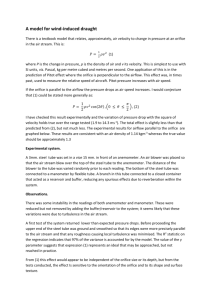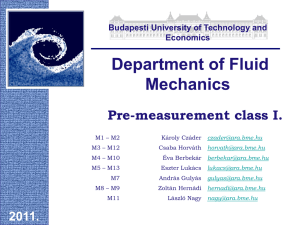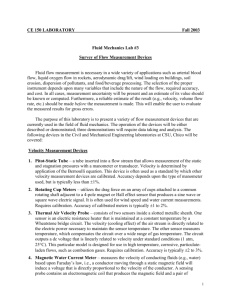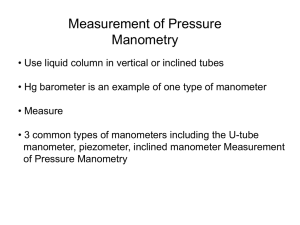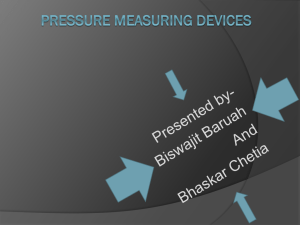Measuring pressure / U tube manometer I.
advertisement
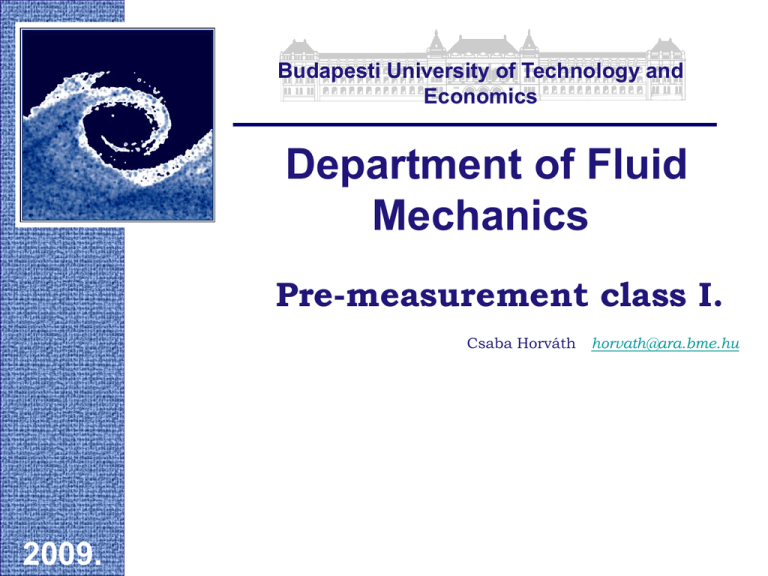
Budapesti University of Technology and Economics Department of Fluid Mechanics Pre-measurement class I. Csaba Horváth 2009. horvath@ara.bme.hu General information • Department webpage: www.ara.bme.hu • Student information page: www.ara.bme.hu/poseidon (materials, test scores, etc.) • Schedule: 2 pre-measurement classes + 3 measurements (A,B and C) + 2 presentations 1. For the first presentation, the A and half of the B measurement leaders will make presentations 2. For the second presentation, the second half of the B and all of the C measurement leaders will make presentations • The measurement reports are due within one week of the measurement date, on Friday at noon. The submitting student must send an email to the faculty member checking the report, to notify them that they have submitted the report. The faculty member will correct the report within 3 days and send a message to the student, through the Poseidon network, to let them know if the report has been accepted, corrections need to be made or if the measurement needs to be repeated. If corrections need to be made, the students can consult the faculty member. The corrected reports need to turned in within 2 weeks from the measurement, at noon. An email must once again be sent to the faculty member correcting the report. Measuring pressure • U tube manometer • Betz manometer • Inclined micro manometer • Bent tube micro manometer • EMB-001 digital handheld manometer Measuring pressure / U tube manometer I. • Pipe flow • Butterfly valve • Average the pressure on pressure taps around the perimeter The manometers balance equation: pB pJ H p 1 ny gH p 2 ny g ( H D h ) m g D h g > p 1 p 2 ( m ny ) g D h ny <<m (For example> measuring air with water) D Dp m g Dh Or (Measuring water with mercury) D p ( m ny ) g D h Notice that D p f ( H ) p p B J Measuring pressure / U tube manometer II. The manometers balance equation: D p ( m ny ) g D h Density of the measuring fluid mf (approximately) h igany 1 3 6 0 0 víz 1 0 0 0 alk oh ol kg m kg 3 m kg 840 3 m 3 mercury water alcohol Density of the measured fluid: ny (For example air) levegő plevegő kg 1,19 3 RTlevegő m plevegő = pair -atmospheric pressure [Pa] ~105Pa R - specific gas constant for air 287[J/kg/K] T - atmospheric temperature [K] ~293K=20°C D Measuring pressure / U tube manometer III. Example: the reading: D h 1 0 m m The exactness ~1mm: The absolute error: D h 1m m How to write the correct value with the absolute error(!) D h 1 0 m m 1m m The relative error: D h Dh 1mm 10 mm 0 ,1 10 % Disadvantages: • Reading error (take every measurement twice) • Exactness~1mm • With a small pressure difference, the relative error is large Advantages: • Reliable • Does not require servicing Measuring pressure / upside down U tube micro manometer The manometer’s balance equation Since the upside down U tube manometer is mostly used for liquid measured fluids, the measurement fluid is usually air. The density of air is13.6 times smaller than mercury and therefore the results are much more exact. Measuring pressure / Betz micro manometer The relative error is reduced using optical tools. Exactness ~0,1mm: The absolute error is: D h 1 0 m m 0,1m m The relative error: D h Dh 1mm 10 mm 0 ,01 1 % Measuring pressure / inclined micro manometer The manometers balance equation p1 p 2 m g D h D h L sin Exactness ~1mm, The relative error: L L L Dh sin 1mm 0 ,05 5 % 10 mm sin 30 It is characterized by a changing relative error. D Measuring pressure / bent tube micro manometer Is characterized by a constant relative error and not a linearly scaled relative error. Measuring pressure / EMB-001 digital manometer List of buttons to be used during the measurements On/Off Green button Reset the calibrations „0” followed by the „STR Nr” (suggested) Changing the channel „CH I/II” Setting 0 Pa „0 Pa” Averaging time(1/3/15s) „Fast/Slow” (F/M/S) Measurement range: D p 1 2 5 0 Pa Measurement error: D p 2 Pa Velocity measurement • Pitot tube/probe or Static (Prandtl) tube/probe • Prandtl tube/ probe Velocity measurement / Pitot tube/probe Pitot, Henri (1695-1771), French engineer. Determining the dynamic pressure: p d p ö p st 2 Determining the velocity: v 2 pd 2 Dp v 2 Velocity measurement / Prandtl tube/probe Prandtl, Ludwig von (1875-1953), German fluid mechanics researcher Measuring volume flow rate • Definition of volume flow rate • Measurement method based on velocity measurements in multiple points • • Non-circular cross-sections • Circular cross-sections • 10 point method • 6 point method Pipe flow meters based on flow contraction • Venturi flow meter • Through flow orifice • Inlet orifice • Inlet bell mouth Measurement method based on velocity measurements in multiple points Very important: the square root of the averages ≠ the average of the square roots(!) Example: Measuring the dynamic pressure in multiple points and calculating the velocity from it vi 2 D p1 n v vi i 1 n 2 Dp i 2 v1 2 Dp2 4 2 Dp3 D p1 2 Dp 4 1. 2. 3. 4. D p1 D p 2 D p 3 D p 4 2 4 Volume flow rate / based on velocity measurements I. Non-circular cross-sections 4 q v vdA A q i 1 n v ,i v m ,i D Ai i 1 v m ,1 A1 v m ,2 A2 v m ,3 A3 v m ,4 A4 Av 4 Assumptions: D A1 D A2 ... áll . D Ai A n qv 2 qv 1 1. 2. qv 3 qv 4 3. 4. Volume flow rate / based on velocity measurements II. Circular cross-sections, 10 point (6 point) method •The velocity profile is assumed to be a 2nd order parabola •Steady flow conditions •Prandtl tube measurements of the dynamic pressure are used Si/D= 0.026, 0.082, 0.146, 0.226, 0.342, 0.658, 0.774, 0.854, 0.918, 0.974 Volume flow rate / based on velocity measurements III. Circular cross-sections, 10 point (6 point) method v 1 v 10 v 2 v2 v9 2 Assumptions: A1 A2 ... áll . v3 v8 2 5 v4 v7 2 v5 v6 2 A 5 The advantage of this method as compared to methods based on flow contraction is that the flow is not disturbed as much and is easy to do. The disadvantage is that the error can be much larger with this method. For long measurements it is also hard to keep the flow conditions constant. (10 points x 1.5 minutes = 15 minutes) Si/D= 0.026, 0.082, 0.146, 0.226, 0.342, 0.658, 0.774, 0.854, 0.918, 0.974 Volume flow rate / flow contraction methods Venturi pipe q m vA q m qV vA qV kg s 3 m A1 áll . A2 áll . s qV v 1 A1 v 2 A2 H v1 v 2 A1 A2 p1 ny Bernoulli equation (=constant): p1 2 v1 p2 2 2 m 2 v2 DA Dp v1 2 m ny g D h ny d 4 1 1 d2 2 Dp ny d 4 1 1 d2 p2 Dh Volume flow rate / flow contraction methods Through flow orifice Standard orifice size- pressure difference qV vA d 2 Dp 4 2 qv b = d/D Cross-section ratio d [m] Diameter of the smallest cross/section D [m] Diameter of the pipe upstream of the orifice ReD = Dv/n Reynolds number’s basic equation (characteristic size x velocity)/ kinematic viscosity v [m/s] The average velocity in the pipe of diameter D 2 n [m /s] kinematic viscosity p1 [Pa] The pressure measured upstream of the orifice p2 [Pa] The pressure measured in the orifice or downstream of it Expansion number ((b,t,k)~1 For air the change in pressure is small) Contraction ratio, =(b,Re) (When using the standard it is 0.6) k Heat capacity ratio or Isentropic expansion factor t=p2/p1 Pressure ratio Volume flow rate / flow contraction methods Inlet orifice (not standard) Not a standard contraction – pressure difference d mp 2 D p mp 2 qv 4 0 ,6 d besz 2 qv k 4 2 D p besz Determining the uncertainty of the results (error calculation) I. Example: Pipe volume flow rate uncertainty Pressures measured with the Prandtl tube: p1 =486,2Pa p2 =604,8Pa p3 =512,4Pa p4 =672,0Pa vi 2 Dp i 4 qv v i D Ai A1 i 1 qv 2R T 1 p 2 D p 1RT p A1 D p 1 q v f T , p , D p , állandók Ambient conditions: p =1010hPa T=22°C (293K) R=287 J/kg/K Dp2 D p1 1. Dp3 3. 0,1m2 p RT A2 2 D p 2 RT p A3 2 D p 3 RT A2 D p 2 A3 D p 3 A 4 D p 4 p A4 2 D p 4 RT p q v 0, 3 0 8 2 m 3 2 Uncertainty of the atmospheric pressure measurements, p=100Pa Uncertainty of the atmospheric temperature measurements, T=1K Uncertainty of the Prandtl pressure measurement with the digital manometer (EMB-001) Dp=2Pa 2 . 4. Dp 4 Determining the uncertainty of the results (error calculation) I. Example: Pipe volume flow rate uncertainty R X i X i 1 i n R Dp2 D p1 Typical absolute error 2 qv 1 1 qv p 2 p 1. Dp3 qv 1 1 qv T 2 T qv 1 1 qv ,i Dpi 2 Dpi p, T, Dp) 2 . 3. 4. The absolute error for volume flow rate measurements: 2 qv 2 p 1 T 1 q q v v p 2 T 2 D p i 1 q v ,i D p i 1 2 i 4 The relative error of volume flow rate measurements: qv 0, 0 0 1 9 7 6 0, 2 % qv The results for the volume flow rate: q v 0, 3 0 8 2 6,1 6 * 1 0 5 m 2 3 2 Dp 4 A honlapról letölthető anyagok www.ara.bme.hu/poseidon english login ->username: neptun code (lower case letters), password: NEPTUN CODE (capital letters) „Egyéb tantárgyinformációk” BMEGEATAG01 ->english Or www.ara.bme.hu In english Download „Tantárgyak” BMEGEATAG01 ->english

